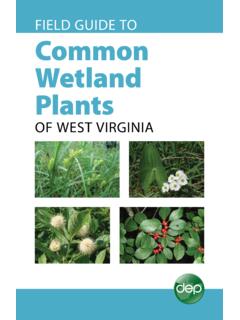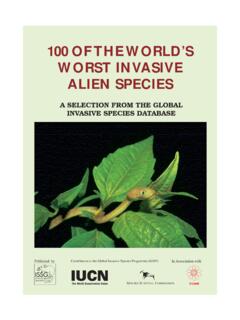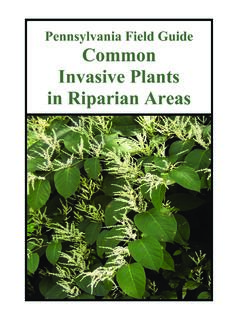Transcription of The Great Britain Invasive Non-native Species Strategy
1 The Great Britain Invasive Non-native Species Strategy August 2015 Crown copyright 2015 You may re-use this information (excluding logos) free of charge in any format or medium, under the terms of the Open Government Licence To view this licence visit or email This publication is available at Any enquiries regarding this publication should be sent to us at The Great Britain Non-native Species Secretariat Animal and Plant Health Agency Sand Hutton York YO41 1LZ Tel: 01904 406615 Email: Cover photographs: Main image - Floating pennywort (Hydrocotyle ranunculoides).
2 Insert images (top to bottom) - Asian hornet (Vespa velutina) [image courtesy of Jean Haxaire]; Killer shrimp (Dikerogammarus villosus); Monk parakeet (Myiopsitta monachus). PB 14324 Foreword In 2008, the first Great Britain Invasive Non-native Species Strategy was published. It built upon the comprehensive review of policy that reported in 2003. The Strategy set out key aims and actions to deliver a co-ordinated approach for addressing the threats posed by these Species . Since 2008, there has been significant progress underpinned by the Strategy including: The establishment of the Non-native Species Information Portal (NNSIP), providing a central repository for Non-native Species information and distribution data; Undertaking and publishing risk assessments for 60 Species , with a further 71 under way; Responding effectively to threats, including efforts to eradicate the ruddy duck, which has seen the population decline from 6,000 in 2000 to around 30 today.
3 Raising awareness through two campaigns focused on aquatic plants ('Be Plant Wise') and recreational water users ('Check Clean Dry'); Undertaking an assessment of the economic impact of Invasive Non-native Species , which indicated an annual cost to the British economy of billion. The UK Government was also instrumental in successfully arguing for collective action across Europe to address these issues, resulting in the European Union s Invasive Alien Species Regulation, which came into force on 1 January 2015. The Regulation will ensure that for the most Invasive and threatening Species an EU-wide approach prevents their entry into and spread across the Single Market.
4 This updated Strategy builds on the successes of the last six years, recognises where more work is required, and sets a series of ambitious aims and objectives which will underpin action over the next five years. Its success will require not only continued strong leadership and direction from government but effective partnerships with environmental NGOs, trade representatives and the voluntary sector. We will be looking to build on and extend these partnerships further in the coming months and years. Lord Gardiner of Kimble Carl Sergeant AM Aileen McLeod MSP Defra spokesman in the Minister for Natural Resources Minister for Environment, House of Lords Welsh Government Climate Change and Land Reform Scottish Government Contents Chapter 1 - Introduction and scope.
5 1 Our vision .. 1 The need for a Strategy .. 2 Successes of the 2008 Strategy .. 3 Chapter 2 - Strategic aims .. 5 Chapter 3 - Prevention .. 6 Chapter 4 - Early detection, surveillance, monitoring and rapid response .. 9 Early detection, surveillance, monitoring .. 9 Rapid response .. 12 Chapter 5 - Long-term management and control .. 15 Chapter 6 - Building awareness and understanding .. 19 Chapter 7 - Cross-cutting provisions .. 21 Governance and co-ordination .. 21 Prioritisation and risk analysis .. 23 Legislation .. 25 Chapter 8 - 27 Chapter 9 - Information exchange and integration.
6 29 Chapter 10 - Implementation and review .. 31 Annex 1 - Key recommendations from the Review of Non-native Species policy: report of the working group , Defra, 2003.. 32 Annex 2 - The GB Non-native Species mechanism .. 33 Annex 3 - Glossary of Key Terms .. 37 1 Chapter 1 - Introduction and scope 1. In 2008, the Invasive Non-native Species Framework Strategy for Great Britain was published. It included a recommendation for evaluation every five years. The first review commenced in 2013 and included six workshops with stakeholders and public consultation on the review s interim findings.
7 Two international experts were also commissioned to review the Strategy from an international perspective. This updated Strategy is the output of that review process. 2. This Strategy aims to address Invasive Non-native Species (INNS) issues in Great Britain (GB), maintaining the approach of the 2008 Strategy and the 2003 policy review. The Strategy covers the terrestrial, freshwater and marine environments and also Species native to one part of a country that become Invasive in areas outside their natural range. The term Non-native Species (NNS) is used throughout this document and is the equivalent of alien Species as used by the Convention on Biological Diversity (CBD).
8 INNS (the equivalent of ' Invasive alien Species ' or IAS ) are broadly defined as Species whose introduction and/or spread threaten biological diversity or have other unforeseen impacts. 3. The scope of the Strategy covers all Non-native Species of flora and fauna with the exception of genetically modified organisms (GMOs), bacteria and viruses. Its full effect, however, is aimed at those Non-native Species that are known to be or are potentially Invasive . The Strategy does not aim to address issues related to human health or formerly native Species , nor does it cover animal or plant diseases although it aims to ensure close working with these areas where appropriate.
9 Our vision 4. Our vision is that if this Strategy is fully implemented, biodiversity, quality of life and economic interests in GB will be better protected against the adverse impacts of INNS because there will be: o widespread awareness and understanding of the risks and adverse impacts associated with INNS, and greater vigilance against these; o integration of INNS within the broader biosecurity agenda; o a strong sense of shared responsibility across government, key stakeholder organisations, land managers and the general public for action and behaviour that will reduce the threats posed by INNS; o a guiding framework for national, regional and local mitigation, control or eradication initiatives helping to reduce the detrimental impact of INNS; and 2 o improved co-ordination and co-operation on INNS issues at a European and international level.
10 The need for a Strategy 5. The 2008 Strategy was drafted in the knowledge that, while the majority of Non-native Species pose little or no risk, INNS are a significant and growing problem; however, the threat to GB was largely unquantified. Now, in 2015, we have considerably more knowledge of the magnitude of the issue we face. There are nearly 2,000 Non-native Species established in GB, most of which are terrestrial ( ,800) with smaller numbers in the marine and freshwater environments ( in each). The number of new arrivals is also increasing with 10-12 new Non-native Species becoming established every year.













